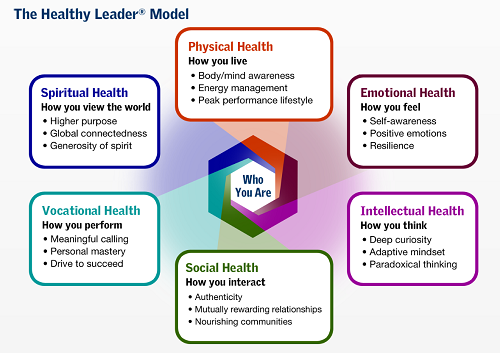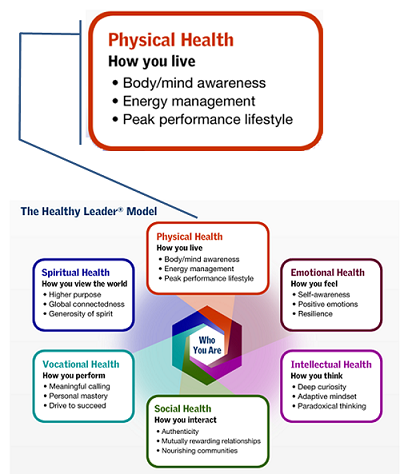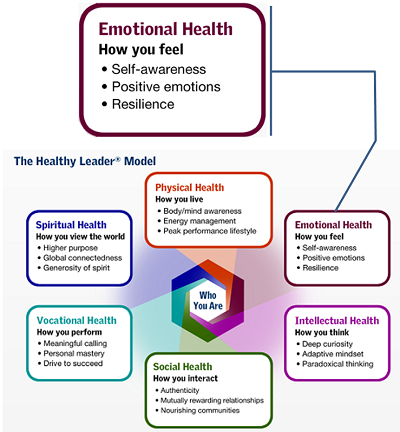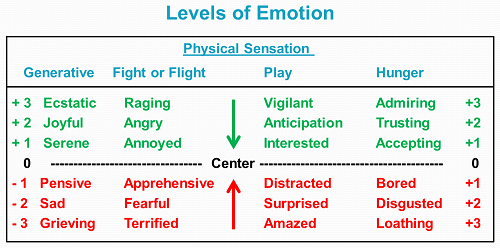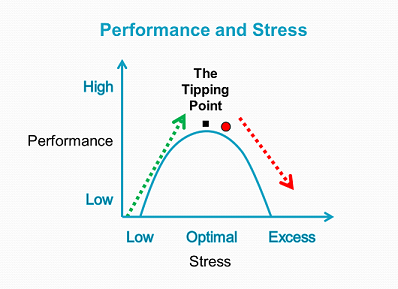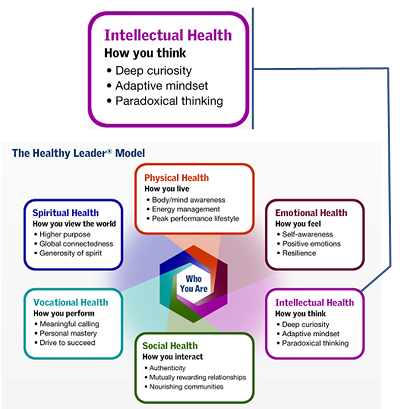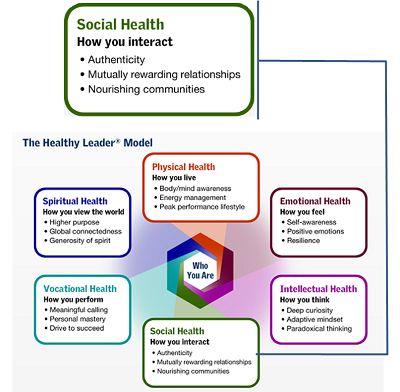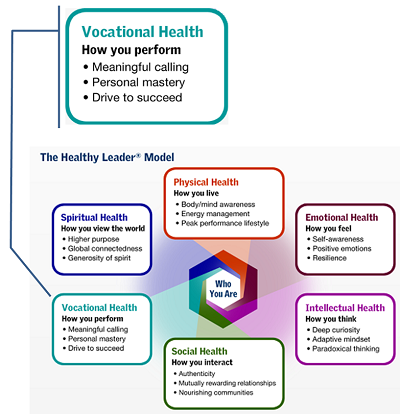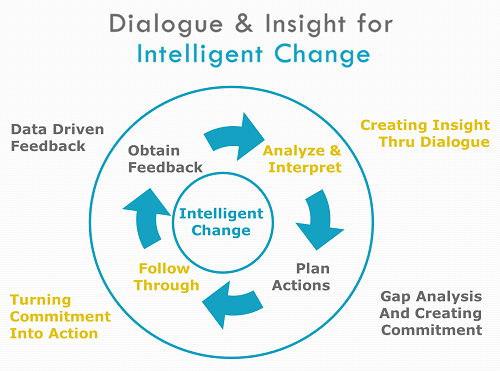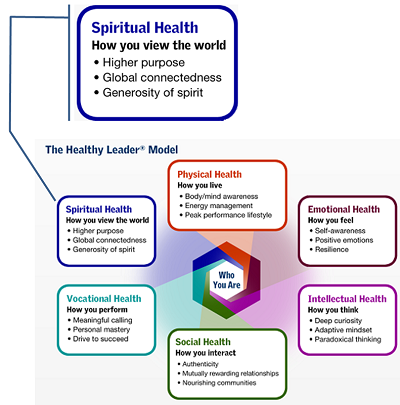When you walk in the room, who shows up for Read more →

Images of Healthy Leadership
Allen Slade
To wrap up my series of posts on the Healthy Leader® model by Bob Rosen of Healthy Companies International, I invite you to enjoy these images of healthy leadership.
The Roots of Healthy Leadership
Image courtesy of Healthy Companies Inc.
Modified from an image courtesy of Healthy Companies Inc.
The Six Aspects of Leadership Health
Modified from an image courtesy of Healthy Companies Inc.
Modified from an image courtesy of Healthy Companies Inc.
Modified from an image courtesy of Healthy Companies Inc.
Modified from an image courtesy of Healthy Companies Inc.
Modified from an image courtesy of Healthy Companies Inc.
Modified from an image courtesy of Healthy Companies Inc.
The Branches of Healthy Leadership
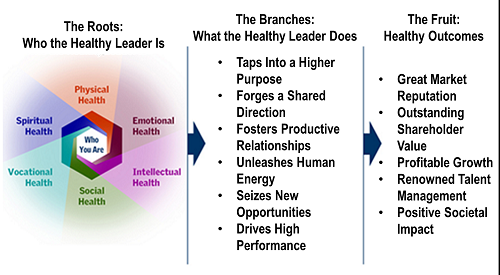 Modified from an image courtesy of Healthy Companies Inc.
Modified from an image courtesy of Healthy Companies Inc.
The Branches of Healthy Leadership
Allen Slade
I like to think of leadership as a tree. For the tree to bear fruit, you need healthy roots and healthy branches.
The roots of leadership are who you are as a leader. Unhealthy roots will stunt the branches and diminish the fruit. In my series of posts on The Healthy Leader® model (from Bob Rosen of Healthy Companies International), we have considered six roots of healthy leadership:
- The leader’s physical health
- The leader’s emotional health
- The leader’s intellectual health
- The leader’s social health
- The leader’s vocational health
- The leader’s spiritual health
Today, let’s look at six branches of healthy leadership – the effective leadership behavior that generates positive outcomes for the organization.
 Modified from an image courtesy of Healthy Companies Inc.
Modified from an image courtesy of Healthy Companies Inc.
Tap into a Higher Purpose
Healthy leaders awaken passion in others. They help their team unite around a common purpose and focus on shared values. They help others have intense pride for the organization.
Forge a Shared Direction
Healthy leaders forge a shared direction with inspiring goals that are owned by the team. They communicate a clear roadmap for success. They align efforts through ownership of broader organizational goals
Foster Productive Relationships
Healthy leaders create productive work relationships for themselves. Healthy leaders model authenticity and generosity. They welcome diversity and competing points of view. They also create an open and productive work environment to help others create productive relationships.
Unleash Human Energy
Healthy leaders are the spark plug that ignites the energy of others. They appreciate individuals. They encourage others to contribute their best self every day, and they recognize their individual contributions. They help map out clear paths for future growth, then they provide challenging roles and stimulating learning opportunities.
Seize New Opportunities
Healthy leaders focus on value creation. They help their team leverage assets to reach goals. They help their team anticipate market moves and capitalize on growth opportunities. And they help their team recover quickly from mistakes.
Drive High Performance
Healthy leaders focus on meeting commitments. They help their team do whatever it takes to consistently get the job done. They empower people to succeed, they measure what matters and they reward success.
Bottom line: If your leadership is a tree, how healthy are the branches? Would your team say that you engage in these healthy leadership behaviors? If not, you may need to enrich your leadership: Tap into a higher purpose. Forge a shared direction. Foster productive relationships. Unleash human energy. Seize new opportunities. Drive high performance.
But be wise. Your behavior flows from who you are. If the branches are not healthy, you may need to look to the roots of healthy leadership first.
What’s your next step? If you are a leader or executive, Slade & Associates can help assess the health of your leadership. We can also provide executive coaching and leadership coaching for individuals who want to enhance who you are and what you do.
If you are a senior executive or a leadership development professional, we can help assess leadership across your organization. Then, working as your partner, we can create customized leadership development programs and coaching systems to make a difference for your leaders.
Whatever your situation, strive for healthy roots and branches to make your leadership fruitful.
The Leader’s Spiritual Health
Allen Slade
When leaders face unpleasant tasks or difficult demands, they must tap into a reservoir of motivation. Their motivation can be internal or external, but if the reservoir is dry, leaders will not be motivated to do what must be done.
Early in my career, my manager would respond to complaints about workload by saying “That’s why they pay us the big bucks.” He was trying to motivate us through the external reservoir of rewards. Since we were paid less than average, his words were not especially motivational.
Yet, my group was quite motivated. We were creative and diligent, we worked long hours without overtime and we changed the company for the better. It was because of our internal reservoir of motivation – our higher purpose, our global connectedness and our generosity of spirit. We discussed our plans in light of the bigger picture. We gave without expecting a return. In other words, our spiritual health kept us going in the face of difficulty.
In my series of posts on The Healthy Leader® model (from Bob Rosen of Healthy Companies International), we have considered the leader’s physical, emotional, intellectual, social and vocational health. Today, let’s look at the leader’s spiritual health.
Modified from an image courtesy of Healthy Companies Inc.
Spiritual health is your ability to tap into a sense of connection with something bigger than yourself and to feel compassion and empathy for others. Spiritual health drives social responsibility and helps us see opportunity in the midst of adversity.
Spiritual health may flow from religious beliefs, but spiritual health is not the same as religion. There are religious believers who are motivated by rewards and punishments, which is not spiritually health. There are people who are not especially religious who have a higher purpose, global connectedness and generosity of spirit. Let’s take a deeper look at the leader’s spiritual health.
Higher Purpose
Do you ever ask yourself “Why am I here?” The spiritually healthy leader has a good answer, because they can see the higher purpose of what they are doing. They work to improve the lives of others. They see the legacy they are building at work. They enjoy fulfilling their organization’s higher purpose and they get a charge out of making a difference in the world.
Knowing why you are here also helps you engage others in your organization. When I became Director of Microsoft People Research, the organization was known for doing an annual employee survey. I helped create a higher purpose for our group and I engaged senior leaders to help contribute to Microsoft’s positive impact on the world. I still have the fleece vest.
Global Connectedness
As the vest says, “Do great research. Create insight. Change Microsoft. Change the World.” Spiritual health goes beyond improving your own work or even your own organization. You strive to improve the world. You see every decision as having the potential to make things better for all. Your vision includes people with different traditions, cultures and religions. You look for the best ideas from around the world and you strive to improve things locally and globally in all of your work.
Generosity of Spirit
Spiritually healthy leaders pay it forward. They do good without expecting to receive something in return. They are optimistic, generous, empathetic and compassionate. They are a role-model for sharing and giving back.
Bottom line: Your spiritual health as a leader flows from your higher purpose, global connectedness and generosity of spirit. By tapping into something bigger than yourself, you will keep your internal reservoir of motivation full for the frustrations you face. You will also be a role model for the people you lead.
The Leader’s Vocational Health
Allen Slade
Decades ago, I heard an old-line manager say “Managers manage and workers work. Never get the two confused.” He saw work as something beneath his pay grade. I suspect his employees felt like cogs in a machine. If so, they probably did the minimum necessary to avoid being “managed”.
The reality is that your vocational health is foundational to your leadership. You lead by example. Your career joy is infectious. Your personal mastery and your drive to succeed set the standard for the people you lead. If you think of work as drudgery, if you don’t control your work self or if you do just enough to get by, your leadership will falter as you pull people down to your level.
In my series of posts on The Healthy Leader® model (from Bob Rosen of Healthy Companies International), we have considered the leader’s physical, emotional, intellectual and social health. Today, let’s look at the leader’s vocational health.
Modified from an image courtesy of Healthy Companies Inc.
Meaningful Calling
Does work energize you or drag you down? Our energy at work is determined in part by our sense of calling. When work is a meaningful calling, it becomes a source of joy and energy for us. When we use our talents fully in our work every day, we are more alive. With my career coaching clients, I talk about calling as the intersection of your ability, your affinity and your career opportunities.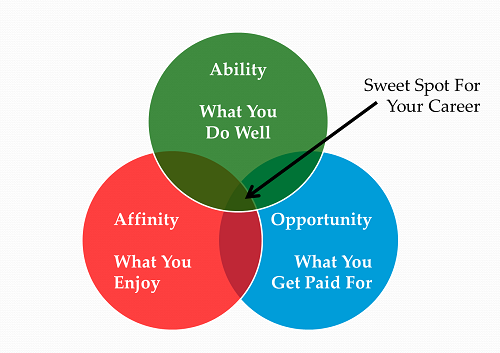 When you are in the sweet spot of your career, your abilities are applied to tasks you enjoy, and your contributions make a difference for the organization. If you are not in your sweet spot, you may need to change your job or change your thinking.
When you are in the sweet spot of your career, your abilities are applied to tasks you enjoy, and your contributions make a difference for the organization. If you are not in your sweet spot, you may need to change your job or change your thinking.
Harsh reality can cause us to work outside our sweet spot. We may enjoy something and be quite good at it, but the need for a living wage may force us to do something else. However, over the long run, it is better to adjust your life style downward to take a job in your sweet spot. When I moved from being a professor at the University of Delaware to an entry level HR job at Ford Motor Company, I took a pay cut. When I moved from Microsoft back to being a professor, I took an even larger pay cut. Yet, both times, I moved into jobs in my career sweet spot.
If your work is not a meaningful calling but you cannot change jobs, don’t be a Debbie Downer. Your vocational health may benefit from a change in thinking. If you expect work to be boring, unchallenging and meaningless, it probably will be. On the other hand, if you come to work with a sense of expectation, you will often find meaning. If you look for what is good, true, beautiful and effective, you will usually find it.
Personal Mastery
Jim Clawson says effective leadership is “managing energy, first in yourself, then in those around you.” Your vocational health rises or falls depending on your desire for self improvement. You need to have a clear view of your strengths and weaknesses and a clear path on how you will improve.
At Slade & Associates, we help our clients pursue intelligent change through dialogue and insight.
Intelligent change starts with feedback that is fleshed out through dialogue. As the leader sees gaps, he or she makes a commitment to try something new – what we call a mini-experiment. After following through with action, the leader gets more feedback and contains the virtuous cycle of growth.
Personal mastery takes openness to feedback, commitment to change and personal insight. These things may or may not be in your habitual approach to work. A leadership coach can help you increase your personal mastery and your vocational health.
Drive to Succeed
Your ability to accomplish goals and outperform your peers is essential for your vocational health. Drive to succeed starts with visualizing success, often as a stretch goal. Then, you have an urgent push to accomplish what you have visualized.
Most managers want people with a high drive to succeed. They do not want people who fear failure so much that they avoid difficult tasks or clear goals.
Drive to succeed is related to the personality construct of need for achievement. My research with Mike Rush shows that people high in need for achievement lean in to difficult tasks. If you are blessed with high drive to succeed, you will have a greater level of vocational health.
People who are low in achievement motivation are high in fear of failure. While they do not avoid more difficult tasks totally, they prefer easier tasks or tasks with no clear measure of success. They may avoid jobs with hard and fast goals (like sales). They may avoid getting the degree they need because of test anxiety, an especially potent effect of fear of failure.
Suppose you experience fear of failure? Are you stuck with low achievement motivation and lesser vocational health? Not at all. Personality is not destiny. You can make choices to succeed, and overtime, those choices will become habits that reshape who you are. I have seen coaching clients overcome fear of failure and become more goal driven. I have helped students overcome test anxiety to graduate with honors and go on to graduate studies. It is a matter of choice, with a bit of coaching or mentoring support.
Bottom line: Your vocational health as a leader is built on meaningful calling, personal mastery and drive to succeed. Through career choices and coaching, you can increase your vocational health so that your leadership flourishes.
The Leader’s Social Health
Allen Slade
Many skills can be put into action without others. We can solve math problems solo. We can read by ourselves. We can create words or visual art alone.
Leadership is not a solo skill. We lead in relationship to others. Our ability to build strong relationships determines our ability to lead. Furthermore, it is not just creating a good first impression that matters. Sustainable leadership requires sustained healthy relationships.
It’s not today’s encounter or today’s sale that matters. It’s all the encounters and the relationships that are going to be fed from today’s sale. If I just care about today’s sale or today’s encounter or today’s exchange, I may make different decisions that affect my whole future. Relationships take a long time to build, and they can be broken very easily.
Atina Diffley Author, public speaker and former organic farmerAs a leader, your health is central to who you are as a leader. In my previous posts on The Healthy Leader® model (created by Bob Rosen of Healthy Companies International), we have considered the leader’s physical, emotional and intellectual health. Healthy leadership also requires social health.
Modified from an image courtesy of Healthy Companies Inc.
Authenticity
Authenticity is being your true self with those you lead. At your best as a leader, you are fully yourself.
Inauthentic leaders rarely set out to deceive. Instead, they compartmentalize or suppress. They may have a work compartment and a home compartment, or they may suppress emotions or thoughts that don’t fit the image they want to project.
Compartmentalizing or suppressing parts of yourself gives off mixed signals. You try to keep value judgments private or hide your annoyance with someone. If you are not a trained actor or a professional poker player, you probably are only partially successful. People may not know specifically what you are hiding, but they are likely to know you are hiding something.
To be authentic, you must be open. Be vulnerable. Let down your defenses. Let others know the real you. It takes courage to open up, but your social health will grow.
Another key to authenticity is consistency. You need to act in similar patterns across time. Your actions should be consistent with your thoughts and emotions. And, your actions need to be consistent with your values and ethics.
Being a better actor is no substitute for authenticity. I worked for a senior executive who launched a new organization. She told a moving story about how she worked with her stepdaughters to pull together as a family. Despite implying domestic happiness, she was separated from her husband and had not seen her stepdaughters for weeks. Yet, she used warm facial expressions, synchronized body movements and perfect tone of voice. Because she was a talented actor, I never totally trusted her again.
When coaching clients ask me how to act differently, I often reply “I don’t give acting lessons.” If you want to act a certain way, you must be that way. If you want to act confident, be confident. If you want act positively, don’t just fake a smile. Notice what is positive in a situation – what is good, true, effective and beautiful. If you want to act as if you are authentic, be transparent and consistent.
Mutually Rewarding Relationships
Healthy relationships are reciprocal relationships. A healthy leader builds relationships that are fair and mutually rewarding. It is not sustainable to treat others as tools to meet your own needs. The socially healthy leader will be quick to help, quick to listen and quick to celebrate the success of others.
Healthy leaders are also open to the perspectives of others. They seek the input of others when making a decision, and they seek feedback about how they are showing up for others.
A healthy leader tends to assume others are acting with positive intent. The leader operates with goodwill, even when there is no “proof” the other person is worthy of being trusted.
Investing in reciprocal relationships tends to pay off. Treating others as trustworthy tends to make you trusted. Seeking input leads to better decisions. Seeking feedback leads to faster growth. Assuming positive motives for others can lead them to grant you goodwill. In other words, mutually rewarding relationships are, well, rewarding.
Nourishing Communities
Humans were created for connections. Couples, families, towns. Sports teams, farmers’ markets, concert audiences. Fire departments, ad agencies, car companies. We come together for good.
As a healthy leader, you do not merely prosper in community. You create healthy communities. You promote collaboration. You identify counterproductive group dynamics and work to improve them. You leverage communities (the power of “&”) to create good, and in doing so, you create joy.
Bottom line: Your social health as a leader flows from authenticity, mutually rewarding relationships and nourishing communities. Your social health invigorates your business success by attracting people to you and your positive vision for the future.
The Leader’s Intellectual Health
Allen Slade
Leadership is all about plugging into the minds and of people. It is about encouraging a spirit of intellectual ferment and constructive dissent so that people are not bound by the status quo, and mavericks are given space and free play.
Kumar Birla Chairman, Aditya Birla GroupAt Slade & Associates, we create dialogue & insight for intelligent change. 
We help our clients be at the top of their mental game. To do so, we have to be at the top of our own mental game.
Being at the top of your mental game requires you to think clearly, critically and creatively in all circumstances. As a leader, intellectual health allows you to make good decisions based on solid insights. Intellectual health is also helps you drive change.
As a leader, it is essential for you to examine your own intellectual health. In the Healthy Leader® model created by Bob Rosen of Healthy Companies International, the leader’s physical health and emotional health are essential. Healthy leadership also requires intellectual health.
Modified from an image courtesy of Healthy Companies Inc.
Deep Curiosity
Intellectual curiosity, at its deepest, reaches outward and inward.
There is an external openness. The leader has a willingness to explore the unknown – seeking new situations, new data and new insights from others. When challenged, the leader wants to explore the differences.
And there is also be an internal openness to new ways of thinking. The leader is willing to challenge her own biases. The leader is willing to approach an issue with alternative perspectives.
Leaders with deep curiosity have the best questions. They go beyond asking about the facts – the who, what or where. They ask how and why. And they actively listen to the answers, curious about what is behind the other person’s thinking.
Are you deeply curious? Do you respond to challenges with openness? Do you ask powerful questions?
Or do you want just the facts? When challenged, do you defend yourself and attack the other person? Do you have more answers than questions?
I encourage you to cultivate your curiosity as a leader and to promote a spirit of inquiry among those you lead. Make extra effort to explore an issue before deciding. And, when someone disagrees with you, see that as a gift.
Adaptive Mindset
Are you intellectually agile? Do you embrace change? Do you constantly reassess your approach? Are you the first to try the new app, take the new class, meet the new person?
Resistance to change is natural, but it can also be intellectually unhealthy. Leaders need openness to change.
Even better, the healthiest leaders initiate change, starting with themselves. Bob Rosen has said “An adaptive mind is a self-transforming mind.”
As the world around us gets more complex, the rate of change is accelerating. You can increase your intellectual adaptability by deliberately embracing the unexpected. You can rewire your thinking so that you lean in to new challenges. You can hold more lightly to your current ways of thinking and acting. Growing your intellectual adaptability increases your leadership range and your managerial effectiveness.
Paradoxical Thinking
Humans often think in dichotomies: Good or bad. Us or them. Go or stop. When we think of people in two groups or cast an issue as right or wrong, we engage in simplistic thinking.
Paradoxical thinking occurs when we hold two conflicting ideas. The healthiest intellects approach a paradox with joy, expecting to be surprised and delighted.
A colleague at Ford Motor Company trained to think paradoxically by repeatedly asking: “So what’s the third alternative?” When faced with high stakes decision that has two choices. What do you do? When faced with a hard choice, a coward equivocates. A decisive leader chooses. A healthy intellect dances on the edge of the paradoxical knife.
Cognitive complexity allows leaders to expand their options. The healthiest intellects don’t boil a decision down to its simplest form. They don’t see people as (all) good or (all) bad. Instead, they keep multiple viewpoints and apparent contradictions in play longer. Paradoxical thinking leads to fewer blind spots, more quickly discarded stereotypes and better decisions. Paradoxical thinking also makes life more fun, because you see the world in color rather than just black and white.
Bottom line: Your intellectual health as a leader flows from deep curiosity, an adaptive mindset and paradoxical thinking. Your intellectual health will help you engage in dialogue and insight so you can lead intelligent change. Your organization will benefit, the people you lead will benefit and you will be prepared for the accelerating pace of change to come.
The Leader’s Emotional Health
Allen Slade
Have you ever worked for a toxic leader? Their very presence sets you on edge. Often, a leader’s lack of emotional health is the source of toxic sewage they spew on others. If your toxic leader had been more self-aware, more positive or more resilient to stress, they might not have triggered fear and loathing.
To guard against becoming a toxic leader, examine your own emotional health. In the Healthy Leader® model created by Bob Rosen of Healthy Companies International, the leader’s physical health is just the starting point. Healthy leadership also requires emotional health.
Modified from an image courtesy of Healthy Companies Inc.
Emotional health is not identical to emotional intelligence. That’s good, because emotional intelligence can be dumb. Emotional health is a better way to think about how our emotions influence our leadership.
Self-Awareness
Are you mindful of your own emotions? You should be aware of your emotional state and know the impact of your emotions on your actions. To help coaching clients become more mindful of their emotions, I suggest three steps:
1. Build a vocabulary of emotions. I like Plutchik’s levels of emotions.
2. Notice your emotions by asking “How am I feeling?” on a regular basis.
3. Reflect on your emotions. How do your emotions serve you? What are your emotional triggers? How do you recover from an emotional hijack?
To be mindful, you also need to be open to feedback. If you see feedback as a problem, you will probably not be as self-aware of your emotions. If you shoot the messenger bearing negative feedback, the messengers will stop coming.
How mindful are you of your emotions? If you need to improve your self-awareness, consider getting a leadership coach or an executive coach to help you notice and manage your emotions.
Positive Emotions
In Georgia, my barber always said farewell with “I appreciate you.” Notice he didn’t appreciate my tip or my business. He appreciated me. Was this just a meaningless habit of a gracious Southern gentleman? I don’t know and I don’t care. It made me feel warm.
Bob Rosen has stated that “Human beings are hardwired for positive emotions. . . . Unhealthy experiences and organizations get in the way of their natural expression.” Americans are pragmatic – we identify problems and drive solutions. As a result, we reward managing negative deviance more than leading with appreciation. A focus on problems can cause you to experience negative emotions most of the time. Since you will project your emotions to the people you lead, you could be the source of toxic sewage.
People don’t enjoy toxic leaders. They enjoy working where they are appreciated. Where the focus is on what is good, true, effective and beautiful. Where problems are secondary to opportunities. Where weaknesses are addressed, but strengths are emphasized.
Do you express positive emotions? How much do you express appreciation for the people around you? How about compassion, love, hope or joy? Do you respond to personal offenses with forgiveness?
Or do you live more on the negative side of emotions? Are you known as a fault finder, a problem solver, a cynic? Do your employees dread meetings with you?
Appreciation comes from the inside. You can rewire your emotions to be more positive. Once again, a good leadership coach can help. So can the right barber.
Resilience
When times are tough, resilient leaders are worth their weight in gold. Your ability to lead in storm weather is based in part on your emotional resilience. A resilient leader buffers stress for others.
Emotional resilience is based in part on your ability to get to the center of an emotional storm. 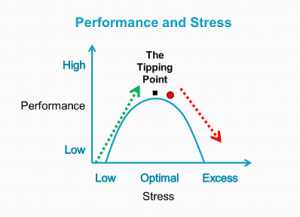 Resilient leaders avoid passing their tipping point of performance, and they manage their own stress to avoid crashing and burning. They know how to create just enough anxiety to drive innovation and change without creating panic.
Resilient leaders avoid passing their tipping point of performance, and they manage their own stress to avoid crashing and burning. They know how to create just enough anxiety to drive innovation and change without creating panic.
How resilient are you? Do you bounce back quickly from setbacks? Are you confident in managing the ups and downs of your organization? Do your employees see you as a stress buffer who helps them through the storm?
Or do setbacks drag you down? Is your confidence only as good as your most recent success or failure? Do your employees see you as a stress amplifier who adds to the drama?
My advice for becoming more resilient is simple, but difficult: Be strong and courageous. There is no easy way to be the leader you should be.
Bottom line: Your emotional health as a leader is based on your self-awareness, your positive emotions and your resilience. How are you doing?
The Leader’s Physical Health
Allen Slade
I think of my time as CEO as more of a marathon than a sprint. So, I’ve really been focused on how do I live healthy enough so that I can stay in this high level of energy for a long period of time. I’ve been dieting. I’ve been working out more. I’m 53. I still theoretically have 12 years to go [until retirement].
John Schlifske Chairman and CEO Northwestern MutualLeadership is like a tree. The leader’s accomplishments are the fruits of leadership. The leader’s actions are the visible parts of the tree – the trunk, branches and leaves. But the roots of healthy leadership are defined by who the leader is. Without healthy roots, there will be no fruit and the tree will wither.
In the NFL combine, high potential athletes are asked to run, jump and lift weights to assess their potential to succeed in professional football. To succeed as a leader, you don’t need to max out your 40 yard dash or vertical leap. Instead, leaders need to be energetic, hardy and have the physical capacity to put out the extra effort needed to succeed. In the Healthy Leader® model created by Bob Rosen of Healthy Companies International, the leader’s physical health is the starting point.
Modified from an image courtesy of Healthy Companies Inc.
Let’s consider each of the three aspects of physical health.
Body/Mind Awareness
To be a healthy leader, you need to understand the link between your physical well-being and your thoughts and emotions. You need to make healthy choices and take actions to manage stress and address illness. You also need to enable your team to have a healthy lifestyle, including adjusting work demands that are causing health issues.
Some leaders are naturally attuned to their bodies and have healthy habits. Others, including me, need to be more deliberate. I don’t exercise out of habit, so I look for external motivation. Right now, I am training for a century – a 100 mile bike ride – because the event gives me a goal that motivates me to work out. If you are driven by your schedule, you may benefit from scheduling time for your health. Other people may be motivated by having an exercise partner or trainer.
Where are you as a leader on Body/Mind Awareness? Do you habitually make healthy choices? If not, create a plan to get yourself heading in the right direction.
Energy Management
Jim Clawson says effective leadership is “managing energy, first in yourself, then in those around you.” In some ways, our capacity to do work is like a battery. Some things drain our energy and other things charge us up. Working long and hard drains us, and rest restores our energy. There are key differences among leaders. Extraverts gain energy from social interactions while introverts are drained by meetings and parties. When facing a day of solitary work, introverts can gain energy as the day goes on, while extraverts need to get out and chat to keep their energy level high.
How effective are you at managing your own energy? When your batteries are running low, can you recharge yourself? I sometimes advise coaching clients in high stress jobs “Go fast to go slow, and go slow to go fast.” In other words, slowing down to recharge yourself can reduce errors and rework.
Managing your own energy is only half the game. You must also manage energy in those around you. In times of stress, some leaders act as stress buffers, providing encouragement and practical help when the impossible deadline is looming. Other leaders add stress by micromanaging and projecting their own fear of failure onto their team. A healthy leader is aware of the energy level of others and takes steps to keep the team’s energy up.
How good are you at managing your own energy? How good are you at managing energy in others? If you need to get better at energy management, the first step is simple: Be mindful of energy levels in yourself and others. Notice what adds energy and what depletes energy. As you notice energy more, you will be able to manage energy better.
Peak Performance Lifestyle
Even a fully charged AA battery will not be able to power your kitchen stove. If energy management is about charging up depleted batteries, peak performance lifestyle is about increasing the size of the batteries. The healthy leader is able to manage stress at home and work, get plenty of sleep and make healthy choices to lead for the long haul. The healthy leader also helps team members have a healthy work-life balance.
Some organizations value employee health, and they provide programs – fitness centers, flexible work arrangements, healthy food at work locations – that support healthy lifestyles. Other organizations see employee health as a cost and do the minimum required by law or the labor market. It can be shorted-sighted to deplete your employees’ health to gain short term performance at minimum cost. As an individual leader, don’t be boxed in by your organization’s lack of support for a peak performance lifestyle. You need to strive for your own peak performance. You also need to takes steps to help your team be healthy and perform well.
Bottom line: As a healthy leader, you need to support the physical health of those you lead. To do that, you need to be aware of your own physical health, manage your energy and strive for a peak performance lifestyle.
The Roots of Healthy Leadership
Allen Slade
For sustained leadership success, you must consider more than just what you accomplish or how you act. You must consider who you are.
Bob Rosen of Healthy Companies International has been researching and writing about leadership health. He has a book coming out soon and because of the partnership between Healthy Companies and Slade & Associates, I would like to give you a sneak peak of Bob’s Healthy Leader® model. Today’s post will share some images of healthy leadership, and over the next month, we will explore the impact of healthy leadership on organizations
Leadership is like a tree. The leader’s accomplishments are the fruits of leadership. The leader’s actions are the visible parts of the tree – the trunk, branches and leaves. But the roots of leadership are defined by who the leader is. Without healthy roots, there will be no fruit and the tree will wither.
The six dimensions of leadership health – physical, emotional, intellectual, social, vocational and spiritual – define who you are as a leader. They are the roots of your leadership.
Image courtesy of Healthy Companies Inc.
Leaders who are healthy have strong roots that lead to effective leadership behavior and positive outcomes for the organization.
 Modified from an image courtesy of Healthy Companies Inc.
Modified from an image courtesy of Healthy Companies Inc.
How healthy is your leadership? By examining the roots of your leadership, by looking at who you are and not just what you do or how much you accomplish, you can create sustainable success for yourself and those you lead.


